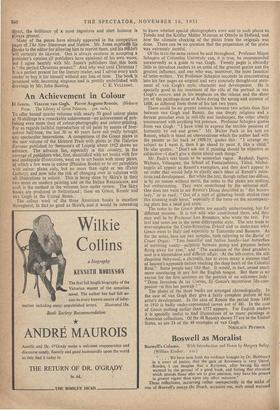An Achievement in Colour
To offer bound quarto volumes with nearly 50 good colour plates at 50 shillings is a remarkable achievement—an achievement of pub- lishing even more than of colour-photography and colour-printing. For as regards faithful reproduction of oil paint by means of four- colour half-tone, the last 30 or 40 years have not really brought any spectacular innovations. A comparison of the Greco plates in the new volume of the Idehurst Press with plates in Die Galerien Europas published by Seemann's of Leipzig about 1912 shOws no advance. The advance lies, especially in this country, in the courage of publishers who, first, dissatisfied with art books with few and inadequate illustrations, went on to art books with many plates, of which a few were in colour (Phaidon Books) or to art pamphlets with colour plates only, but no more than eight or ten (Faber Gallery), and now take the risk of changing over to volumes with all illustrations in colour. This is being done by Skirti's in their two series on modern painting and on the Italian Renaissance, and such is the method in the volumes here under review. The Sidra books are produced in Switzerland ; these on Greco, Renoir and' van Gogh in the United States.
The colour work of the three American books is excellent throughout, in fact as good as Skira's, and it would be interesting to know whether special photographers were sent to such places as Toledo and the Kroller Muller Museum at Otterlo in Holland, and how the ultimate checking of the plates from the originals was done. There can be no question that the preparation of the plates was extremely careful.
Of the texts the same cannot be said throughout. Professor Meyer Schapiro of Columbia University can, it is true, be recommended unreservedly as a guide to van Gogh. Twenty pages is absurdly little to introduce readers to an artist of the greatest genius and the greatest influence, and one who was, moreover, the most fanatical of letter-writers. Yet Professor Schapiro succeeds in concentrating into his few pages an original and very concisely thought-out state- ment of van Gogh's style, character and development. He is specially good in his treatment of the role of the portrait in van Gogh's oeuvre, and in his emphasis on the release and the sheer joy of the paintings done at Arles during the spring and summer of 1888, so different from those of his last two years. There could be no greater contrast between two artists than that between van Gogh and Renoir, the one deeply religious and a fervent preacher even in still-life and landscapes, the other utterly unconcerned with anything but peinture. Professor Schapiro quotes from van Gogh : "I have tried to express the terrible passions of humanity by red and green." Mr. Walter Pach in his text on Renoir, which is based on conversations which the author had with the painter as far back as 1908-19, quotes this: "I arrange my subject as I want it, then I go ahead to paint it, like a child." He also quotes: "Don't ask me if painting should be objective or subjective—I don't give a damn about such things."
Mr. Pach's text tends to be somewhat vague. Raphael, Ingres, Watteau, Velasquez, the School of Fontainebleau, Titian, Michel- angelo all appear as Renoir's exemplars, and they don't appear in an order that would help to clarify one's ideas of Renoir's inten- tions and development. But while the text, though rather too diffuse, is by no means without merit, the notes to the plates are nothing but embarrassing. They were contributed by the editorial staff. One does not want to see Renoir's Diana described as "this buxom lady," or to read : "Out of a mist of glittering brush strokes rises this stunning nude torso," especially if the torso on the accompany- ing plate has a head and arms.
The notes to the Greco plates are equally embarrassing, but for different reasons. It is not said who contributed them, and they may well be by Professor Leo Bronstein, who wrote the text. For text and notes are in the same dithyrambic style. The text tends to over-emphasise the Creto-Byzantine Erbteil and to understate what Greco owes to Italy and 'especially to Tintoretto and Bassano. As for the notes, here are two samples, both referring to the Burial of Count Orgaz: "Two beautiful and festive hands—lost butterflies of surviving vanity—palpitate between pomp and greyness before flying away for ever," and "The ascension Of the dead grandee's soul is a tremendous and' difficult affair. At the left-centre, the still shapeless baby-soul, a chrysalis, has to cross many a sinuous road of heaven's approach before reaching the deep heart of the Celestial Rose." Some people may like that. It would, in fact, sound much more convincing in any but the English tongue. But there is no excuse for the first sentence on the portrait of an unknown lady : "Dona Jeronima de las Cuevas, El Greco's mysterious life-com- panion—is this her portrait ? " The plates of the three' books are arranged chronologically. In the case of van Gogh they give a fairly complete picture of the artist's development. In the case of Renoir the period from 1890 to 1910 is badly under-represented (seven out of 48). In the case of Greco nothing earlier than 1577 appears. For English readers it is specially useful to find illustrations of so many paintings in American collections. Of the 48 Renoirs shown 37 are in the United States, as are 24 of the 48 examples of van Gogh.
NIKOLAUS PEV.SNE-R,














































































 Previous page
Previous page